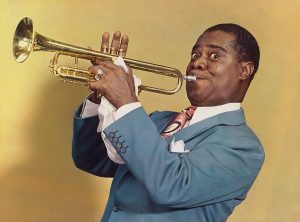Paul Whiteman Day
March 28, 1890 – December 29, 1967
A birthday tribute to the most popular bandleader of the 1920s
Click here if you have a memory of this artist that you’d like to share
–
Click here to Support Jazz on the Tube
Bandleader Paul Whiteman was born on March 28, 1890 in Denver, Colorado.
The son of a respected music teacher, Whiteman began playing violin when he was seven and performed with the Denver Symphony Orchestra during 1907-14.
After moving to San Francisco and serving briefly in the Navy (where he led a 40-piece band), in 1918 Whiteman began leading his own dance band at San Francisco’s Fairmont Hotel.
It became his goal to “uplift” the new jazz music and make it respectable (he said “to make a lady out of jazz”) and accessible to a large audience.
Whiteman took his band to Los Angeles later in 1918, spent time in Atlantic City, and in 1920 moved to New York.
The early band with cornetist Henry Busse as its star soloist had big hits with “Whispering,” “Japanese Sandman,” “Wang Wang Blues,” and “Hot Lips,” becoming the most popular dance orchestra of the 1920s.
They toured Europe in 1923 and on February 24, 1924 Whiteman’s concert at Aeolian Hall introduced George Gershwin’s “Rhapsody In Blue” with the composer on piano.
Billed by a press agent as “The King Of Jazz” (“the King of the Jazz Age” would have been more accurate), Whiteman’s music actually contained relatively little jazz until 1926-27 when, aware of the problem, he hired Red Nichols, Tommy Dorsey, Jimmy Dorsey, Bing Crosby (who was teamed with Harry Barris and Al Rinker as the Rhythm Boys) and, most importantly by the fall of 1927, Bix Beiderbecke, Frankie Trumbauer and arranger Bill Challis.
Whiteman always put on a variety show but particularly during late-1927-1929 he recorded some worthy jazz performances, with Bix getting many brief but memorable spots.
1930’s The King Of Jazz was an overblown film but it had a half-dozen bright moments featuring members of the orchestra
The Depression and changes in musical tastes resulted in Whiteman cutting back on the size of his ensemble and he remained as a nostalgic figure who never really fit into the swing era (although Jack Teagarden played with him for five years), appearing in some other films and keeping his orchestra together (other than a brief retirement in 1940) until 1942 with brief reunions in later years; he was mostly content in later years to conduct programs of Gershwin’s music.
Here is Paul Whiteman, from the 1930 film The King Of Jazz, introducing some of his musicians including trumpeter Harry Goldbfield, a priceless 90 seconds from violinist Joe Venuti and guitarist Eddie Lang, clarinetist Izzy Friedman and pianist Roy Bargy, trombonist Wilbur Hall and banjoist Mike Pingitore
-Scott Yanow
Click here if you have a memory of this artist that you’d like to share
–


